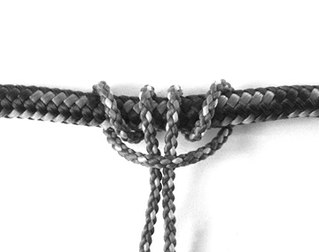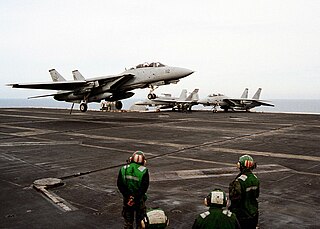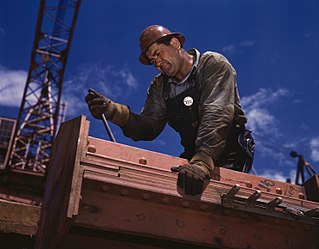
A pulley is a wheel on an axle or shaft that is designed to support movement and change of direction of a taut cable or belt, or transfer of power between the shaft and cable or belt. In the case of a pulley supported by a frame or shell that does not transfer power to a shaft, but is used to guide the cable or exert a force, the supporting shell is called a block, and the pulley may be called a sheave.

A winch is a mechanical device that is used to pull in or let out or otherwise adjust the tension of a rope or wire rope. In its simplest form, it consists of a spool attached to a hand crank. Winches are the basis of such machines as tow trucks, steam shovels and elevators. More complex designs have gear assemblies and can be powered by electric, hydraulic, pneumatic or internal combustion drives. It might include a solenoid brake and/or a mechanical brake or ratchet and pawl which prevents it unwinding unless the pawl is retracted.

A mooring refers to any permanent structure to which a vessel may be secured. Examples include quays, wharfs, jetties, piers, anchor buoys, and mooring buoys. A ship is secured to a mooring to forestall free movement of the ship on the water. An anchor mooring fixes a vessel's position relative to a point on the bottom of a waterway without connecting the vessel to shore. As a verb, mooring refers to the act of attaching a vessel to a mooring.

A block and tackle is a system of two or more pulleys with a rope or cable threaded between them, usually used to lift heavy loads.

A curtain is a piece of cloth intended to block or obscure light, or drafts, or water. A curtain is also the movable screen or drape in a theater that separates the stage from the auditorium or that serves as a backdrop.
The term jockey wheel predominantly refers to a wheel-based mechanical system used for steering or guidance. It is either

A Prusik is a friction hitch or knot used to attach a loop of cord around a rope, applied in climbing, canyoneering, mountaineering, caving, rope rescue, ziplining, and by arborists. The term Prusik is a name for both the loops of cord and the hitch, and the verb is "to prusik". More casually, the term is used for any friction hitch or device that can grab a rope. The word is often misspelled as Prussik, Prussick or Prussic, as it is a homophone with the term prussic acid.

An arresting gear, or arrestor gear, is a mechanical system used to rapidly decelerate an aircraft as it lands. Arresting gear on aircraft carriers is an essential component of naval aviation, and it is most commonly used on CATOBAR and STOBAR aircraft carriers. Similar systems are also found at land-based airfields for expeditionary or emergency use. Typical systems consist of several steel wire ropes laid across the aircraft landing area, designed to be caught by an aircraft's tailhook. During a normal arrestment, the tailhook engages the wire and the aircraft's kinetic energy is transferred to hydraulic damping systems attached below the carrier deck. There are other related systems which use nets to catch aircraft wings or landing gear. These barricade and barrier systems are only used for emergency arrestments for aircraft without operable tailhooks.

A windlass is a machine used on ships that is used to let-out and heave-up equipment such as a ship's anchor or a fishing trawl. On some ships, it may be located in a specific room called the windlass room.

In physics, tension may be described as the pulling force transmitted axially by the means of a string, cable, chain, or similar one-dimensional continuous object, or by each end of a rod, truss member, or similar three-dimensional object; tension might also be described as the action-reaction pair of forces acting at each end of said elements. Tension could be the opposite of compression.
In horology, a maintaining power is a mechanism for keeping a clock or watch going while it is being wound.

A rigger is a person who specializes in the lifting and moving of extremely large or heavy objects, often with the assistance of a crane or derrick or chain hoists.

Theater drapes and stage curtains are large pieces of cloth that are designed to mask backstage areas of a theater from spectators. They are designed for a variety of specific purposes and come in several types; many are made from black or other dark colored, light-absorbing material, and heavyweight velour is the current industry standard for these. Theater drapes represent a portion of any production's soft goods, a category which includes any cloth-based element of the stage or scenery.
A rigger is one who works on ropes, booms, lifts, hoists and the like for a stage production, film, or television show.

A Z-Drag or Z-Rig is an arrangement of lines and pulleys commonly used in rescue situations. The basic arrangement provides a theoretical mechanical advantage of three. The name comes from the fact that the arrangement of lines is roughly Z shaped. Besides the mechanical advantage to pulling, it also uses only part of the total length of the rope for the block and tackle arrangement.

A differential pulley, also called "Weston differential pulley", sometimes "chain hoist" or colloquially "chain fall", is used to manually lift very heavy objects like car engines. It is operated by pulling upon the slack section of a continuous chain that wraps around pulleys. The relative size of two connected pulleys determines the maximum weight that can be lifted by hand. The load will remain in place until the chain is pulled.
A draw-works is the primary hoisting machinery component of a rotary drilling rig. Its main function is to provide a means of raising and lowering the traveling block. The wire-rope drill line winds on the drawworks drum and over the crown block to the traveling block, allowing the drill string to be moved up and down as the drum turns. The segment of drill line from the drawworks to the crown block is called the "fast line". The drill line then enters the first sheave of the crown block and makes typically 6 to 12 passes between the crown block and traveling block pulleys for mechanical advantage. The line then exits the last sheave on the crown block and is fastened to a derrick leg on the other side of the rig floor. This section of drill line is called the "dead line."

A hydraulic jigger is a hydraulically powered mechanical winch.






















